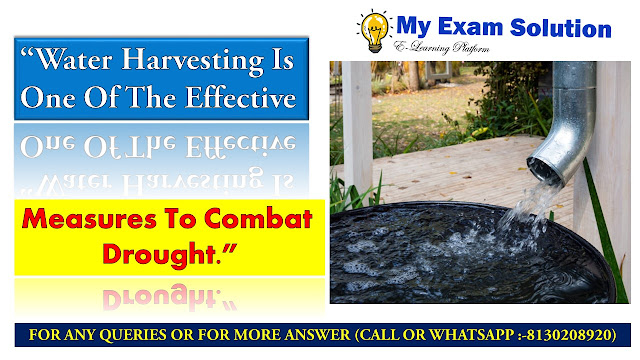“Water Harvesting is one of the effective measures to combat drought.”
Water harvesting is a technique that captures, diverts, and stores rainwater for later use. It is an effective measure to combat drought because it allows for the collection and storage of water during periods of high precipitation, which can then be used during periods of low precipitation or drought.
Here are some arguments to support the statement "Water
harvesting is one of the effective measures to combat drought":
- Increased water availability: Water harvesting allows for the collection and storage of water during times of high precipitation, which can then be used during times of low precipitation or drought. This can help to ensure a consistent water supply and reduce the effects of drought.
- Reduced dependence on surface water: By collecting and storing water from rain and other sources, water harvesting can help to reduce dependence on surface water sources, such as rivers and lakes, which can be affected by drought.
- Cost-effective: Water harvesting can be a cost-effective measure to combat drought, as it does not require the construction of large-scale infrastructure or the use of expensive treatment methods.
- Improving soil health: Water harvesting can also help to improve soil health by reducing soil erosion and increasing the amount of water available to plants. This is particularly beneficial during periods of drought when water is scarce.
- Reducing water waste: By collecting and storing rainwater, water harvesting can also reduce the amount of water wasted through runoff.
- Combating climate change: Water harvesting can also help to combat the impacts of climate change by reducing the demand for groundwater and surface water, which can be affected by changes
What is the use of water harvesting
Water harvesting refers to the technique of capturing,
diverting, and storing rainwater for later use. The use of water harvesting can
be used in various ways, such as:
- Irrigation: Water harvesting allows for the collection and storage of rainwater, which can then be used for irrigation during periods of low precipitation or drought. This can help to ensure a consistent water supply for crops and reduce the need for irrigation from surface water sources.
- Domestic use: Water harvesting can also be used for domestic purposes, such as for drinking, cooking, and bathing. This can help to reduce the demand for water from municipal sources, particularly during times of drought.
- Livestock: Water harvesting can also be used to provide water for livestock, such as cattle and sheep, during periods of drought.
- Industrial use: Water harvesting can also be used for industrial purposes, such as in mining, manufacturing, and power generation.
- Recreational use: Water harvesting can also be used for recreational purposes, such as in swimming pools, fountains, and water features.
- Ecosystem: Water harvesting can also be used for the benefit of ecosystem, such as creating wetlands, ponds, and lakes to support aquatic life.
- Fire Fighting: Water harvesting can also be used for fire fighting purposes, such as in case of forest fires.
Overall, water harvesting is a flexible and cost-effective
technique that can be used in a variety of ways to meet different water needs,
particularly during periods of low precipitation
What do you mean by water harvesting
Water harvesting refers to the collection, storage, and
distribution of rainwater for later use. It is a technique that captures
rainwater from rooftops, surfaces, and other catchment areas, diverts it into
storage tanks or reservoirs, and then distributes it for various purposes such
as irrigation, domestic use, livestock, industrial use, recreation and
ecosystem, etc. The water is collected from natural sources like rain and
stored in manmade structures like cisterns, tanks, ponds, and reservoirs. The
water can be harvested from both surface runoff and subsurface flow.
Water harvesting can be done on a small scale, such as by
households collecting rainwater in barrels or tanks, or on a larger scale, such
as by municipalities or companies building large-scale water storage
facilities. It is an effective way to conserve water, particularly in regions
where water is scarce or unreliable. Water harvesting can also help to reduce
the demand on surface water sources and groundwater, and can be used to improve
soil health and reduce runoff.
What is water harvesting and its advantages?
Water harvesting is the collection, storage, and distribution
of rainwater for later use. It is a technique that captures rainwater from
rooftops, surfaces, and other catchment areas, diverts it into storage tanks or
reservoirs, and then distributes it for various purposes such as irrigation,
domestic use, livestock, industrial use, recreation and ecosystem, etc. The
water is collected from natural sources like rain and stored in manmade
structures like cisterns, tanks, ponds, and reservoirs.
The advantages of water harvesting are:
Increased water availability: Water harvesting allows for the
collection and storage of water during times of high precipitation, which can
then be used during times of low precipitation or drought. This can help to
ensure a consistent water supply and reduce the effects of drought.
Reduced dependence on surface water: By collecting and
storing water from rain and other sources, water harvesting can help to reduce
dependence on surface water sources, such as rivers and lakes, which can be
affected by drought.
Cost-effective: Water harvesting can be a cost-effective
measure to conserve water, as it does not require the construction of
large-scale infrastructure or the use of expensive treatment methods.
Improving soil health: Water harvesting can also help to
improve soil health by reducing soil erosion and increasing the amount of water
available to plants. This is particularly beneficial during periods of drought
when water is scarce.
ALSO READ:-







0 comments:
Note: Only a member of this blog may post a comment.